IoT-enabled pneumatic technologies ensure clean and reliable food and beverage design.
Contributed by Amit Patel, Product Marketing Manager, Food & Beverage, Emerson
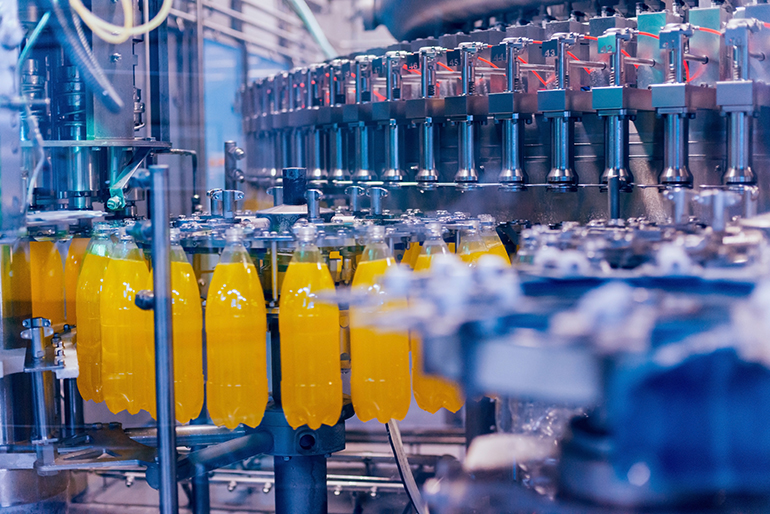
Image courtesy of Adobe stock
Pneumatics has always been a go-to technology in food and beverage applications, and for good reason. Pneumatics technology is clean and reliable, and it’s safe and easy to maintain. It also has design features that improve performance and potentially lower cost.
And now, with the advent of the Industrial Internet of Things (IIoT), pneumatics is an even better choice for food and beverage applications. With IIoT connectivity, processing equipment can be safer to operate and predictive maintenance can be enhanced. Plus, energy use can be monitored and controlled more closely.
IIoT connectivity
Pneumatics equipment can now be equipped with sensors that measure key operating parameters, like temperature, pressure, flow rates, cycle times, valve response rate and more. Using this information, designers can monitor machine performance more closely than ever before.
Original Equipment Manufacturers (OEMs) can now include pneumatic monitoring capabilities that can detect a pneumatic system’s operating state, analyze the data and forward alerts to the right people in an organization. They can provide reliable information on the condition of actuators, valves and other devices.
These new capabilities are being enabled as part of the IIoT functionality.
Edge devices to crunch the data
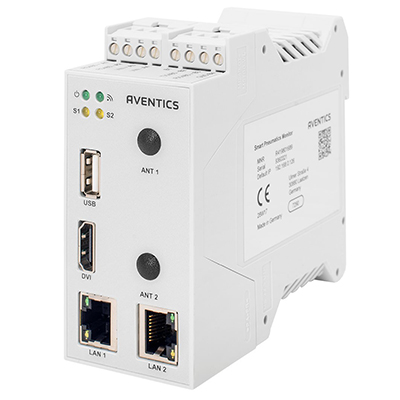
An edge device like Emerson’s AVENTICS Smart Pneumatics Monitor module provides the user with reliable information on the state of wear of pneumatic actuators, valves and other devices as well as the energy efficiency of pneumatics systems.
With all that new data, it would be easy to overwhelm users who are just beginning their IIoT journey or for facilities where now greater demand is placed on the central control device such as a PLC.
However, a number of manufacturers like Emerson have created edge gateways designed to capture data from machine components and analyze it at the local factory level, comparing the performance to design parameters. That happens without sending the information to the machine control or the cloud. When the sensor data indicates a machine is operating outside the target ranges, the edge device sends alerts to the appropriate people. And only the outlier data is forwarded to the central control or the cloud.
These edge devices can be deployed anywhere throughout the plant, handling up to 250 inputs. That probably may not be enough for an entire plant. But it could certainly monitor the mission-critical functions needed for one processing line or area of the plant.
Connecting sensors on pneumatics components to an edge gateway sets the stage for major improvements in maintenance and safety as well as energy use.
Enhanced maintenance
Because wear and tear are such a fact of life in any industrial setting, maintenance is where IIoT capabilities become so helpful. Plant operators can implement a whole new level of predictive maintenance, using IIoT-enhanced pneumatics. By comparing a machine’s performance to established set points, the IIoT edge device can notify the appropriate manager if the system isn’t meeting the established standards.
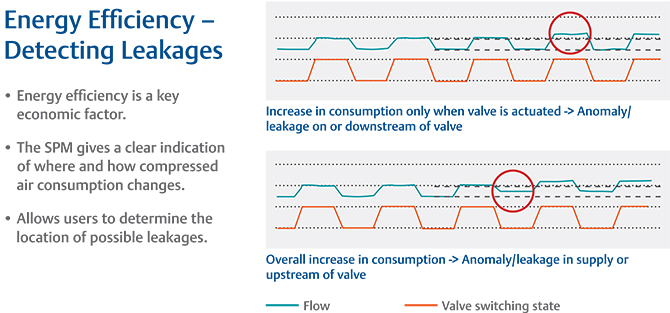
Energy efficiency is a key economic factor.The SPM gives a clear indication of where and how compressed air consumption changes.
This allows users to determine location of possible leakages.
For instance, maintenance technicians could determine that a shock absorber on the end of an actuator is deteriorating, just by sensing an increase in cycle speed, even by a few milliseconds. Or machine builders could take advantage of the diagnostic features of IIoT-enhanced pneumatics to measure critical parameters like cylinder velocity.
In either case, knowing which equipment needs maintenance allows plant engineers to potentially avoid unplanned downtime, replacing components with shorter and fewer planned machine stops.
A safer workplace
Pneumatics technology is already highly regarded for its contribution to worker safety, incorporating several safety features and components that protect operators and equipment, prevent downtime, improve reliability and extend operational life. The IIoT enhances pneumatics technology even further, providing new tracking and measurement capabilities.
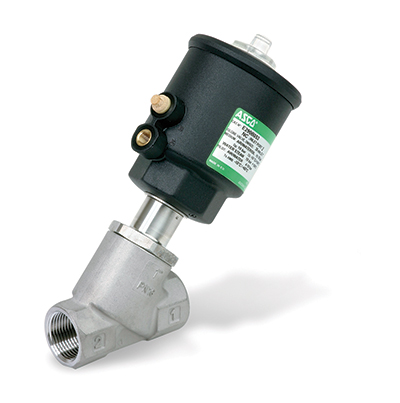
The Emerson ASCO 8290 Series angle-body multipurpose pneumatically operated valve is a two-way, direct-acting valve where the internal wetted components comply to Food Safe (EC-1935/2004) and FDA (CFR 21) making it highly suitable for auxiliary fluids such as steam or water.
These new features give operators even greater insight into the performance of a machine and its components and subsystems.
A good example would be a machine with a safety light curtain controlling a valve. If the valve response time changed from 30 to 50 msec, or even 70 msec, an operator would be able to get much further into the dangerous motion area of a machine before a safety response event could be triggered. Normally, that kind of situation would not have been noticed or addressed before the device reached its mission time replacement cycle. However, with IIoT capability, that decline in the valve response time (and the corresponding alert response time) would be captured, analyzed and reported in time for corrective action — before any deterioration in functionality that would put the machine operator at risk.
In addition, Emerson’s new, integrated, scalable, zoned safety approach requires fewer connections and saves valuable real estate within the machine and manifold, reducing the number of safety system components by up to 35%. It helps design engineers satisfy regulations by allowing up to three safety zones to be isolated on a machine from a single pneumatics assembly. A valve manifold can be configured to shut down pilot air and power only to the equipment that will come in contact with the operator, leaving the rest of the machine in operation.
Energy use
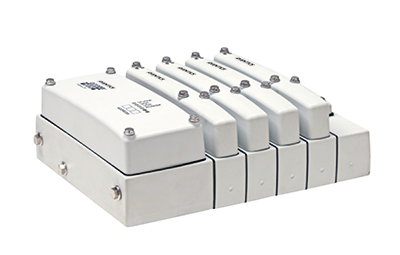
The AVENTICS CL03 from Emerson features an especially high protection class of IP69K, suitable for sanitary design.
Fluid leaks can cause huge energy losses in mechanical systems and it’s often difficult to pinpoint the cause or the source of the problem. By monitoring the pressure and flow of these systems, plant operators can track their energy usage and identify potential problems before they occur.
With the data gathered from the sensors on pneumatics components, IIoT edge devices identify leaks and monitor energy usage and air consumption.
Examples where this can be valuable is for the actuation of critical components such as automated hygienic valves which are used throughout a facility moving vital process/consumable media. Once again, alarms or alerts can be sent to the appropriate managers.
Other advantages of pneumatics
Beyond IIoT connectivity, pneumatics technology offers a wide range of other benefits for food and beverage producers, including:
- Cleanliness. Pneumatics equipment is ideal for work where frequent washdowns are required. There are even pneumatics valves for sanitary conditions, withstanding aggressive detergents and chemicals.
- Reliability. Pneumatics equipment is less complex than other power technologies and, as a result, is known for dependable operation with less downtime. Pneumatics valves are engineered for high actuation rates and can handle high-speed production or high-speed motion sequences for packaging or for safe, rapid and reliable control of process valves and auxiliary valves for processing such as the Emerson ASCO 8290 series.
- Cost. On a component-by-component comparison, pneumatics devices generally have a lower initial cost than electronics. And in operation, pneumatics technology is extremely cost-effective, becoming most efficient when the total demand nears the capacity of the compressor. Plus, there is little added cost to add more devices, since compressed air is already being used throughout most food and beverage plants.
- Training. As food and beverage processors deploy pneumatics throughout their plants, they’re finding their teams need less ramp-up and training time with the introduction of new equipment.
Pneumatics technology: a good fit for food and beverage
Always a strong contender for any food and beverage application, pneumatics technology has been enhanced with the addition of Industrial Internet of Things capability. It’s clean and reliable, cost-effective and easy to maintain. And now it has enhanced capabilities for preventive maintenance, worker safety and energy savings.
Best of all, it’s not only scalable, it actually becomes more efficient as plant operators add more equipment — not simply as the total demand for pneumatics nears the capacity of the air compressors, but as plant workers become more familiar and comfortable with the technology.
Emerson
emerson.com
Filed Under: Pneumatic Tips, Valves & Manifolds